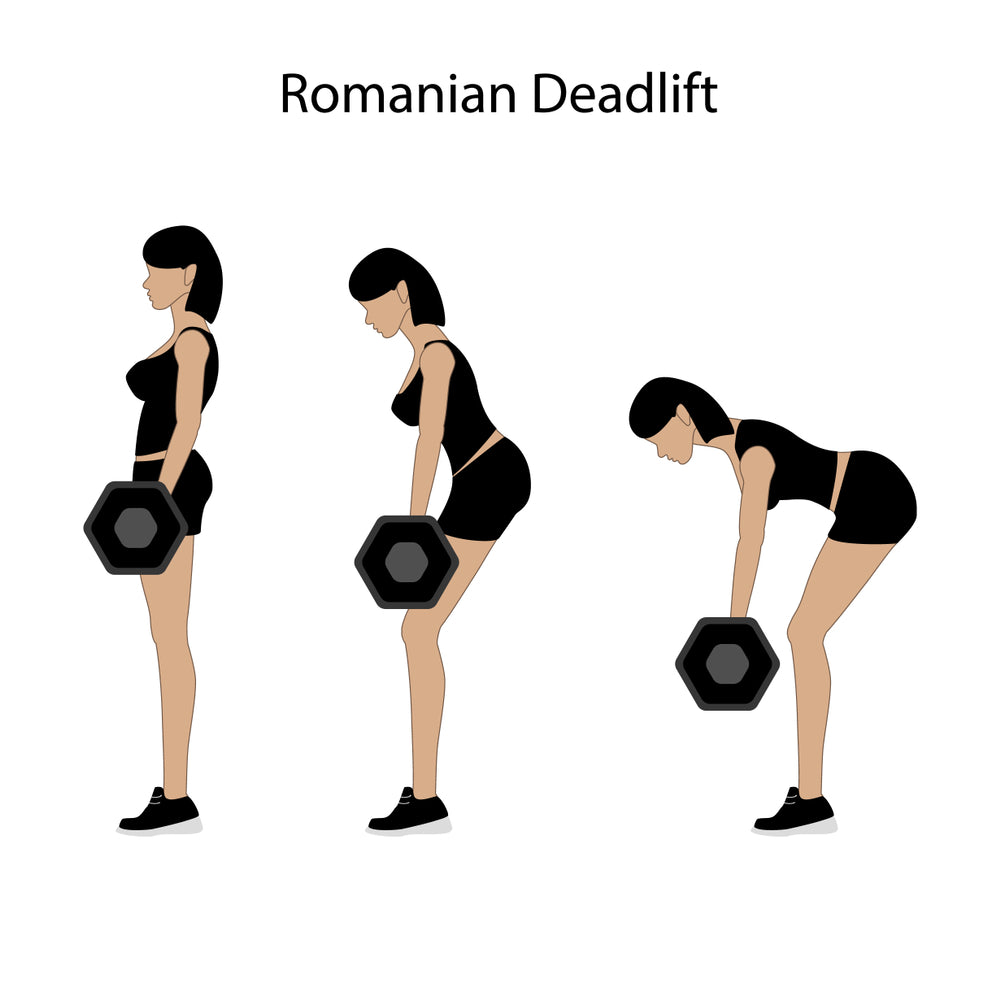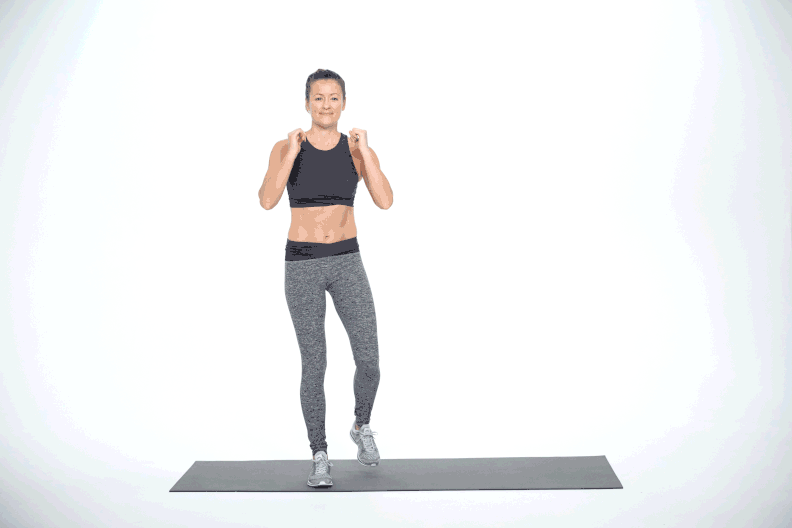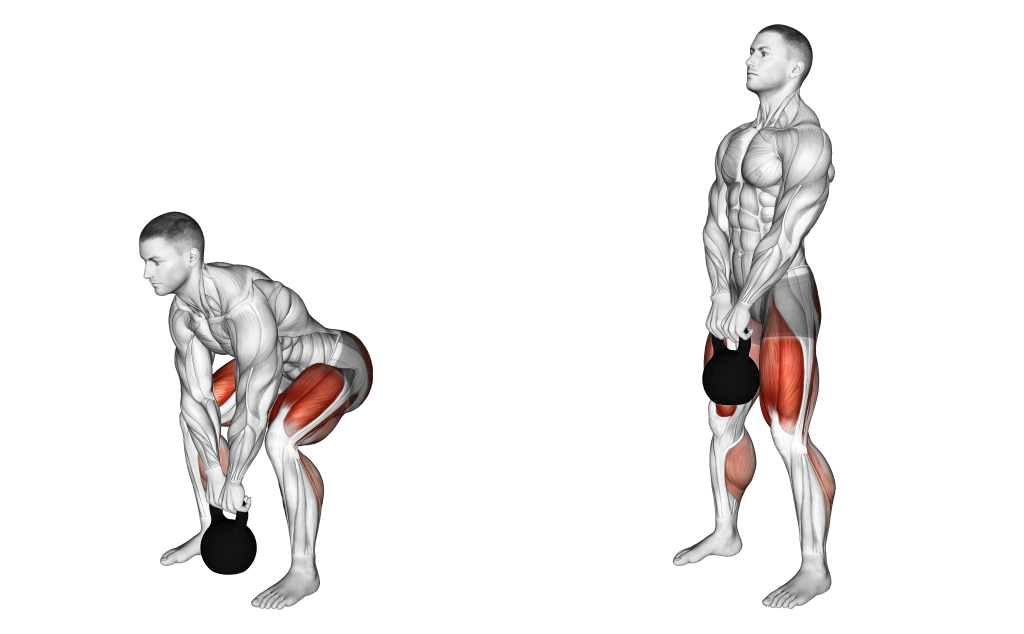In the landscape of strength training, the Romanian deadlift (RDL) takes centre stage, showcasing its versatility and effectiveness, often drawing comparisons to the traditional deadlift. This comprehensive guide intricately explores the world of Romanian deadlifts, uncovering their multifaceted benefits, precise techniques, varied adaptations, and the crucial distinctions that distinguish them from the conventional deadlift. As fitness enthusiasts navigate through this comprehensive resource, they gain a deeper understanding of the nuanced elements that make Romanian deadlifts a vital component in the pursuit of strength, muscle development, and overall well-being.
Romanian Deadlift vs. Deadlift: Understanding the Difference
While both Romanian deadlifts and conventional deadlifts target similar muscle groups, the mechanics and execution differ significantly.
Unlike the traditional deadlift that starts from the ground, the Romanian deadlift begins with the weight at hip height. The focus shifts to the posterior chain, emphasizing the hamstrings and glutes. This contrast not only alters muscle engagement but also influences the range of motion, making Romanian deadlifts an excellent complement to deadlifts for targeting specific muscle groups with precision.
Muscles Worked During Romanian Deadlifts

Hamstrings
- The hamstrings are heavily engaged during Romanian deadlifts, particularly in controlling the descent and powering the ascent. This results in strengthened hamstrings and improved knee stability.
Glutes
- The gluteus maximus, medius, and minimus contribute significantly to hip extension during the upward phase of the Romanian deadlift. This engagement enhances overall hip strength and stability.
Lower Back (Erector Spinae)
- The erector spinae muscles play a crucial role in maintaining an upright posture throughout the movement, stabilizing the spine and preventing excessive flexion.
Core Muscles (Rectus Abdominis, Obliques, Transverse Abdominis)
- The core muscles work to stabilize the spine and prevent excessive arching or rounding of the back. This engagement contributes to improved core strength and overall stability.
Quadriceps
- While not the primary focus, the quadriceps assist in knee extension during the upward phase of the Romanian deadlift.
Adductor Magnus
The adductor magnus muscle plays a role in hip adduction, which is the movement of bringing the thighs together towards the midline of the body. In the context of the Romanian deadlift (RDL), the adductor magnus can be involved in stabilizing and supporting the movement.
Benefits of Romanian Deadlifts
Romanian deadlifts (RDLs) stand out as a cornerstone in the realm of strength training, providing a wealth of benefits that elevate their significance in any comprehensive workout routine. Foremost among these advantages is the unparalleled development of hamstring and glute strength. The controlled descent inherent in the RDL, coupled with a deliberate emphasis on the eccentric phase, creates an environment conducive to substantial muscle growth and heightened muscular endurance. This targeted strengthening not only cultivates a more robust lower body but also establishes a foundation for improved athletic performance.
In addition to the specific muscle benefits, Romanian deadlifts play a pivotal role in refining hip hinge mechanics. The exercise demands a conscious engagement of the hip muscles, teaching the body to hinge at the hips with precision. This nuanced approach not only fosters a more efficient movement pattern but also contributes to overall hip flexibility. Importantly, the emphasis on controlled movements and proper form significantly reduces the risk of lower back strain, making Romanian deadlifts a reliable and safe exercise for enhancing both strength and flexibility.
Incorporating Romanian deadlifts into a regular strength training regimen thus becomes more than just a means of building muscle; it becomes a strategic investment in overall lower body health, athletic prowess, and injury prevention.
A Step-by-Step Guide to Romanian Deadlifts
Executing Romanian deadlifts with proper form is crucial for maximizing their benefits and minimizing the risk of injury.
- Begin with feet hip-width apart, a barbell or kettlebells in hand, and shoulders retracted.
- Initiate the movement by pushing the hips back while maintaining a slight bend in the knees.
- Keep the barbell or kettlebells close to the body, traveling down the front of the legs.
- Lower the weights until you feel a stretch in the hamstrings without compromising your back's alignment.
- Engage the hamstrings and glutes to return to the starting position, maintaining control throughout.
What are the Variations of Romanian Deadlift?
Single-Leg Romanian Deadlifts
Taking the benefits of RDLs further, the single-leg Romanian deadlift adds an element of balance and stability to the equation.
How to Do
- Stand with feet hip-width apart, maintaining a neutral spine and shoulders back.
- Shift your weight onto one leg, hinge at the hips, and extend the other leg straight back.
- Lower your torso towards the ground while keeping the extended leg, back, and neck in a straight line. Emphasize maintaining balance and control.
Benefits
- Single-leg RDLs enhance balance by isolating each leg, promoting stability through the entire movement.
- Targeting each leg individually helps address potential muscle imbalances, fostering overall lower body symmetry.
- The exercise activates stabilizing muscles in the core, contributing to improved overall balance and core strength.
Kettlebell Romanian Deadlift
The kettlebell variation of the RDL serves as an innovative twist, preserving the foundational benefits of the traditional exercise while injecting a new dimension of range of motion and control.
How to Do
- Stand with feet hip-width apart, holding a kettlebell in each hand with arms extended in front.
- Hinge at the hips, lowering the kettlebells towards the ground while maintaining a straight back.
- Engage the hamstrings and glutes to return to the starting position.
Benefits
- The kettlebell variation enhances the stretch in the hamstrings, promoting improved flexibility.
- Holding kettlebells adds a dynamic challenge, engaging stabilizing muscles for heightened control.
- Holistic Muscle Engagement: Targets the hamstrings, glutes, and lower back for comprehensive strength development.
Dumbbell Romanian Deadlift
This variation adds a layer of precision to strength training, offering a targeted approach to muscle engagement.
How to Do
- Stand with feet hip-width apart, holding a dumbbell in each hand with arms extended in front.
- Hinge at the hips, lowering the dumbbells towards the ground while keeping a neutral spine.
- Engage the hamstrings and glutes to return to the starting position.
Benefits
- Dumbbells allow for focused targeting of specific muscle groups, refining muscle isolation.
- The inclusion of dumbbells intensifies the resistance, contributing to increased strength and endurance.
- Suitable for various fitness levels, providing an adaptable approach to strength training.
Banded Romanian Deadlift
A variation that introduces an innovative twist to the conventional RDL by incorporating resistance bands. This adaptation amplifies the exercise's dynamic nature, providing a variable level of tension throughout the movement.
How to Do
- Secure a resistance band beneath the feet and hold it in each hand, arms extended in front.
- Hinge at the hips, lowering the hands towards the ground while keeping a straight back.
- Engage the hamstrings and glutes to return to the starting position, resisting the tension of the band.
Benefits
- The resistance band introduces variable tension, challenging muscles throughout the entire range of motion.
- The Banded RDL supports progressive resistance, aiding in continual strength development.
- Resisting the band's tension enhances stability, contributing to improved dynamic strength and control.
Nutrition and Recovery for Romanian Deadlifts
- Essential for muscle repair and growth.Its sources are Lean meats, poultry, fish, eggs, dairy, plant-based proteins.
- Primary energy source for workouts.Its sources are Whole grains, fruits, vegetables.
- Supports joint health and overall energy. Its sources are Avocado, nuts, seeds, olive oil.
- Critical for overall health and muscle function.Drink water throughout the day, and increase intake on workout days.
- Replenishes glycogen stores and supports muscle recovery.Protein shakes, lean protein with carbohydrates can be taken.
- Essential for recovery and muscle growth. Aim for 7-9 hours of quality sleep per night.
- Promotes blood flow and reduces muscle soreness.Gentle activities like walking, yoga can be included in your routine.
Safety Precautions for Romanian Deadlifts
Maintain Proper Form
- Ensure a neutral spine with a slight natural curve in the lower back.
- Keep the barbell or weights close to the body throughout the movement.
Controlled Descent
- Lower the weights in a controlled manner, avoiding rapid or jerky movements.
Appropriate Weight
- Start with a manageable weight to master the technique before progressing.
Warm-Up
- Engage in a dynamic warm-up to prepare the muscles and joints for the exercise.
Foot Placement
- Keep the feet hip-width apart with a slight bend in the knees.
Breathing Technique
- Inhale as you lower the weights and exhale during the upward phase.
Romanian Deadlift Workout Plan
Note: Adjust weights and intensity based on individual fitness levels.
Beginner
- Romanian Deadlifts: 3 sets x 10-12 reps (light to moderate weight)
- Bodyweight Lunges: 3 sets x 12 reps each leg
- Plank: 3 sets x 30 seconds
Intermediate
- Romanian Deadlifts: 4 sets x 8-10 reps (moderate to heavy weight)
- Goblet Squats: 3 sets x 12 reps
- Russian Twists: 3 sets x 20 reps (with or without weight)
Advanced
- Romanian Deadlifts: 5 sets x 6-8 reps (heavy weight)
- Single-Leg Romanian Deadlifts: 3 sets x 10 reps each leg
- Hanging Leg Raises: 3 sets x 15 reps
Progression Tip
Gradually increase weights as strength improves. Focus on maintaining proper form and listen to your body to prevent overtraining and injuries. Consult with a fitness professional or healthcare provider if you have any pre-existing conditions or concerns.
If you prefer a durable and versatile option, check out the Kettlebell Kings Powder Coat Kettlebell renowned for its reliability and durability.For versatile training options, consider exploring our collection of adjustable kettlebells. With adjustable weights, these kettlebells offer flexibility to tailor your workouts to your desired intensity levels.
Addressing Common Questions
Q.What are Romanian Deadlifts Good For?
A: Romanian deadlifts are particularly effective for developing hamstring and glute strength, enhancing hip hinge mechanics, and improving overall flexibility.
Q.What is the Difference Between a Deadlift and a Romanian Deadlift?
A:While both exercises target similar muscle groups, Romanian deadlifts begin at hip height, emphasizing the posterior chain and altering the range of motion compared to conventional deadlifts.
Q.What are Romanian Deadlifts Proper For?
A:Romanian deadlifts are proper for developing posterior chain strength, improving hip flexibility, and addressing muscular imbalances, especially when performed with proper form.
Q.What is the Difference Between a Squat and a Romanian Deadlift?
A:The primary difference lies in the movement pattern and muscle engagement. Squats involve bending at the knees with a more upright torso, while Romanian deadlifts focus on a hip hinge, engaging the hamstrings and glutes.
Conclusion
Incorporating Romanian deadlifts into your strength training routine offers a myriad of benefits, from targeted muscle development to improved flexibility and balance. This guide has delved into the intricacies of Romanian deadlifts, uncovering their unique benefits, proper form, variations, and distinctions from conventional deadlifts. Beyond the mechanical nuances, the RDL becomes more than a muscle-building tool—it transforms into a strategic investment in overall lower-body health, athletic prowess, and injury prevention.
To harness the full potential of Romanian deadlifts, a detailed exploration of muscle engagement, step-by-step execution, and variations has been provided. From the single-leg RDL to kettlebell, dumbbell, and banded variations, each adaptation adds a distinctive dimension to strength training. Addressing nutrition, recovery, safety precautions, and offering a customized workout plan, this guide equips enthusiasts with a comprehensive understanding, encouraging a purposeful integration of Romanian deadlifts into their fitness journey.
Whether opting for the traditional or single-leg variation, mastering the proper form ensures a safe and effective workout. The kettlebell adaptation adds a dynamic element, maximizing the exercise's range of motion. As you unlock the potential of Romanian deadlifts, you're not only sculpting a stronger physique but also refining your movement patterns for overall functional fitness.










